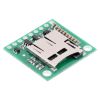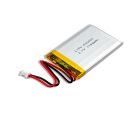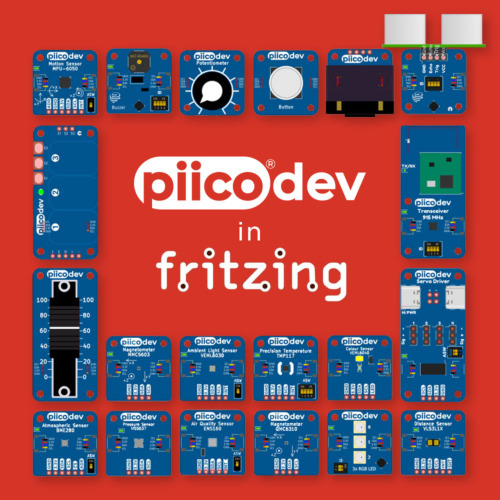Breakout Board for microSD Card with 3.3V Regulator and Level Shifters
In stock, ships same business day if ordered before 2PM
Delivered by Tue, 16th of Dec
Quantity Discounts:
- 10+ $11.74 (exc GST)
- 25+ $11.37 (exc GST)
 |
This carrier board makes it easy to interface a microSD memory card (originally known as TransFlash) with an SPI-capable microcontroller, offering a convenient and inexpensive way to add gigabytes of non-volatile storage to an embedded project. It includes a 3.3 V regulator and level shifters on the four SPI lines, enabling direct integration into 5 V systems, and it provides access to the all of the connections through single 1×9 row of 0.1"-spaced through-holes. A breakaway 0.1" male header strip is included, which can be soldered in to use the board with breadboards, perfboards, or 0.1" female connectors, and the board has two mounting holes for #2 or M2 screws.
For 3.3 V projects, Pololu carry a smaller Breakout Board for MicroSD Card without the 3.3 V regulator, level shifters, and mounting holes. This more basic module (shown in the right picture below) breaks out all of the microSD pins (including the ones used for the SD bus mode interface) rather than just the SPI-interface pins.
|
|
For a microSD socket and user-programmable microcontroller on a single board, consider Pololu's A-Star 32U4 Prime controllers, which essentially use the same level-shifting circuits to interface a microSD card with an Arduino-compatible ATmega32U4 MCU running at 5 V.
Using the breakout board
Since many microcontrollers have built-in SPI interfaces, most hobbyist projects communicate with Secure Digital cards in SPI bus mode; this is the only mode supported by this board. (The alternative SD bus mode is proprietary, and a license from the SD Association is required for access to the full specifications.) The pins on this board are labeled according to their functions in SPI mode.
 |
| Pin | Description | ||
|---|---|---|---|
| EN | Enables the 3.3 V regulator. This pin is pulled-up to VDD through a 100 kO resistor to enable the regulator by default. | ||
| CD | Card detect. This pin is pulled up to VDD through a 100 kO resistor. When a card is inserted, it is high; when no card is inserted, it is shorted to ground. | ||
| CS | Chip select (must be driven low to talk to the microSD card) | ||
| SCLK | SPI clock | ||
| DO | SPI data out (MISO) level shifted to 5 V | ||
| DI | SPI data in (MOSI) | ||
| 3V3 (OUT) | Output from the 3.3 V regulator | ||
| GND | Power and logic ground | ||
| VDD | Supply voltage (5 V) | ||
The board is powered by applying 5 V to the VDD pin, and all of the logic pins can be interfaced directly with 5 V systems thanks to integrated level shifters. The output of the integrated 3.3 V regulator can be accessed through the 3V3 pin, and the regulator can be disabled to turn off the microSD card and save power by driving the EN pin low.
By default, the EN and CD (Card Detect) pins are each pulled up to VDD through 100 kO resistors. However, there are cuttable traces on the underside of the board to allow you to disconnect each pull-up as desired. These traces are located between pairs of pads (labeled “EN” and “CD” on the board’s silkscreen) that can be bridged with solder to reconnect the pull-up resistor. Alternatively, the neighboring EN and CD pads of these surface-mount jumpers (highlighted in the picture below) can be connected if you want the regulator to automatically be enabled when the microSD card is inserted and disabled when it is removed.
 |
Communicating with a microSD card
The SD Association publishes a set of simplified specifications for SD cards containing information on interfacing with them. However, there are a number of ways to get started without understanding the specifications or writing your own code from scratch, since many microcontroller development platforms provide libraries for communicating with SD cards. For example:
- The SD library for Arduino provides functions for accessing files and directories on an SD card. (It also works with Arduino-compatible boards like Pololu's A-Star programmable controllers.)
- The SD Card File System library for mbed allows similar filesystem access.
Schematic
 |
Breakout Board for Micro SD Card with 3.3V Regulator and Level Shifter schematic diagram. |
|---|
This schematic is also available as a downloadable pdf (106k pdf).
People often buy this product together with:
 | VL6180X Time-of-Flight Distance Sensor Carrier with Voltage Regulator, 60cm max |
 | Romi Chassis Ball Caster Kit - Black |
 | Romi Encoder Pair Kit, 12 CPR, 3.5-18V |
Dimensions
| Size: | 0.94" × 0.9" × 0.12"1 |
|---|---|
| Weight: | 1.8 g2 |
Identifying markings
| PCB dev codes: | scd02a |
|---|---|
| Other PCB markings: | 0J8867 |
Notes:
- 1
- Without a microSD card or the included optional header pins. When inserted, a microSD card will extend approximately 35 mil (0.85 mm) past the edge of the board.
- 2
- Without a microSD card or the included optional header pins.
File downloads
-
Breakout Board for Micro SD Card with 3.3V Regulator and Level Shifters schematic diagram (106k pdf)
Printable schematic of Breakout Board for Micro SD Card with 3.3V Regulator and Level Shifters.
-
Drill guide for the Breakout Board for microSD Card with 3.3V Regulator and Level Shifters (33k dxf)
This DXF drawing shows the locations of all of the board’s holes.
Recommended links
-
The SD Association’s simplified standard specifications for SD cards.
Exact shipping can be calculated on the view cart page (no login required).
Products that weigh more than 0.5 KG may cost more than what's shown (for example, test equipment, machines, >500mL liquids, etc).
We deliver Australia-wide with these options (depends on the final destination - you can get a quote on the view cart page):
- $3+ for Stamped Mail (typically 10+ business days, not tracked, only available on selected small items)
- $7+ for Standard Post (typically 6+ business days, tracked)
- $11+ for Express Post (typically 2+ business days, tracked)
- Pickup - Free! Only available to customers who live in the Newcastle region (must order online and only pickup after we email to notify you the order is ready). Orders placed after 2PM may not be ready until the following business day.
Non-metro addresses in WA, NT, SA & TAS can take 2+ days in addition to the above information.
Some batteries (such as LiPo) can't be shipped by Air. During checkout, Express Post and International Methods will not be an option if you have that type of battery in your shopping cart.
International Orders - the following rates are for New Zealand and will vary for other countries:
- $12+ for Pack and Track (3+ days, tracked)
- $16+ for Express International (2-5 days, tracked)
If you order lots of gear, the postage amount will increase based on the weight of your order.
Our physical address (here's a PDF which includes other key business details):
40 Aruma Place
Cardiff
NSW, 2285
Australia
Take a look at our customer service page if you have other questions such as "do we do purchase orders" (yes!) or "are prices GST inclusive" (yes they are!). We're here to help - get in touch with us to talk shop.
Have a product question? We're here to help!
Guides
The Maker Revolution
Projects
PiicoDev Ecosystem In Fritzing
10" Home Lab Testing Rack
WLED Hourglass Theatre Prop - DMX Over Wi-Fi!
Makers love reviews as much as you do, please follow this link to review the products you have purchased.






















Product Comments